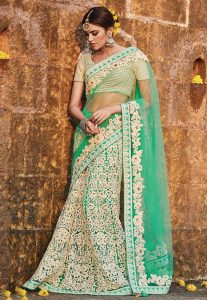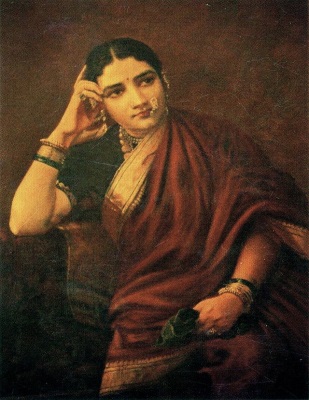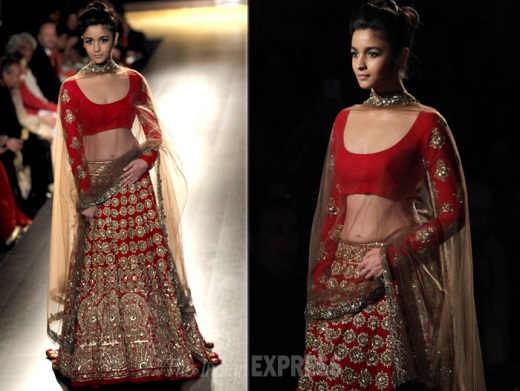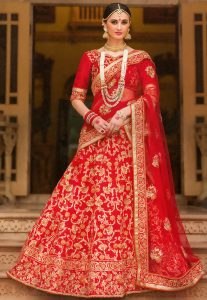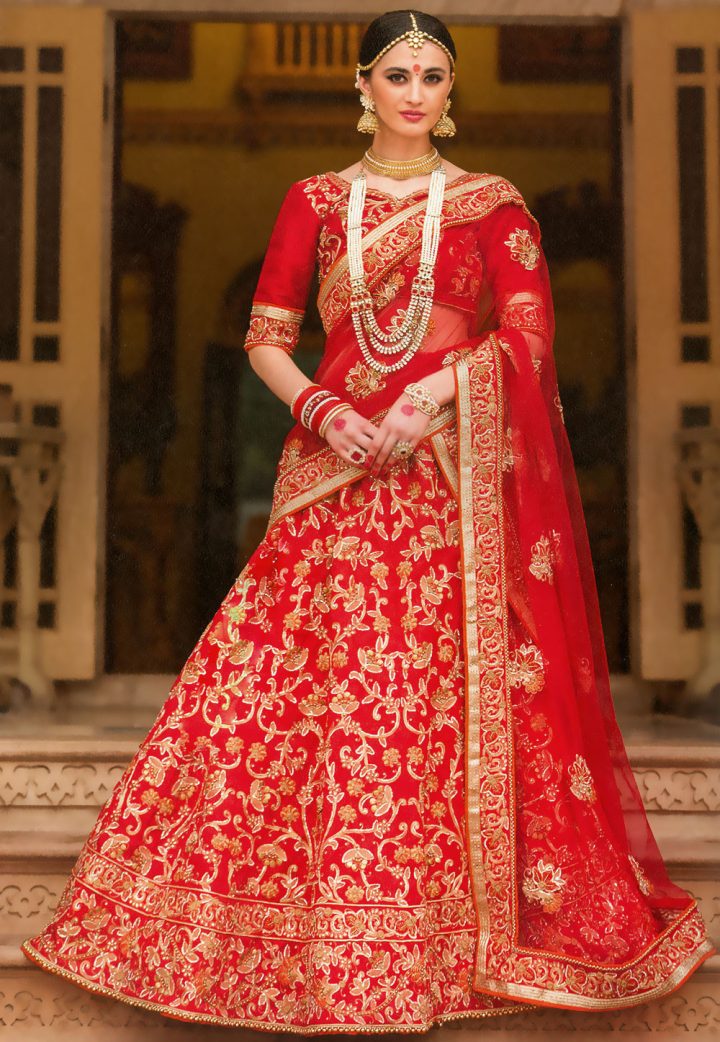
Lehenga Style Saree
The lehenga style saree or the lehenga saree is a fusion of two ethnic Indian outfits merged into one beautiful, easy-to-wear garment. With a skirt that brings the lehenga element of the dress into play, the pallu refers to the saree whereas the top-wear can be inspired from either. Emerging as the latest party wear outfit, lehenga style sarees offer the best of both worlds i.e. the elegance of the saree and the convenience of a lehenga. Both on and off the runway, lehenga style sarees are marking the latest innovations in Indian ethnic fashion.
The Origin
The individual elements of this outfit i.e. the lehenga and the saree, have different individual origins and unique histories. The lehenga, for instance, emerged from the Bhairnivasani which in turn was derived from the Antariya which was stitched only on one side and gathered at the waist, held together by a drawstring. This was the earliest form of the lehenga.
The saree, on the other hand, has different origins, depending on which part of the Indian culture one looks at. The most ancient of them is traced to the Indus Valley Civilization where a priest is wearing a drape similar to the saree. However, the current equivalent of the Indian saree is referred to in the Jatakas (Buddhist Jain literature) in its description of the Indian woman’s attire.
The lehenga style saree arose from a need for convenient-to-wear party attire that is also grand and beautiful. The concept behind this outfit is ‘slip, tuck, drape’ i.e. to say that the lehenga can be slipped into, the readymade pleats tucked in, the pallu took over the shoulder and the woman is ready in a matter of minutes.
Sources of Inspiration
While clearly the lehenga style saree is inspired by two of its namesakes, it is also a reflection of a challenge to a patriarchal mindset that says ‘women take ages to just get ready’. This easy to slip on party wear has transpired to beat the load of a busy schedule of a modern woman who not only has to juggle multiple tasks but also aspires to look gorgeous at a party or an event.
The Making
The length of the entire piece, it is semi-stitched, varies between 4.5 m to 5.5 m. Since the garment is split into different elements the making of each is such:
- The skirt: The skirt can be stitched in various styles, flared, mermaid, etc. according to the designer’s collection. However, the common thread is that all such garments have the pleats pre-made and stitched into the skirt itself. A zip is given on the side so that all one has to do is slip into it and zip it up.
- The pallu: One end of the pallu is sown into the skirt from where the wearer need only drape it over the shoulder. Many a times the pallu is sold separately, making this garment more like a lehenga outfit than a saree.
- The blouse: The top can be stitched in the style of the choli or a blouse according to the designer’s preference and the vision of the overall look.
Style and Variety
A number of variations that the lehenga style saree has to offer can be categorized into designs, fabrics, and style of the blouses as well as the drape. Within designs, one can see all kinds of work being done on this fabric such as zari, zari-gota work, zardozi, sequins, stone-work, resham embroidery, paisley designs, jacquard weaving, silver motifs in thread work, lace borders and more.
The fabrics that are most commonly used to make this garment include georgette, chiffon, crepe, viscose blends, jacquard looms, Lurex blends, and other light materials. These fabrics are specifically used because of their lightness, fall, and malleability to the intended shape.
The style of the blouses can be anywhere between halter necks to full sleeved ones, deep neck ones and backless blouses.
The drape of the lehenga style saree depends on the designer. While some come with an attached pallu, others have a free dupatta that can be draped as the wearer wishes. There are no boundaries on the colors that complement a lehenga style saree, giving the wearer a plethora of options to choose from.
Present Day Scenario and Global Influence
Lehenga style sarees are gradually emerging as the preferred outfits for special occasions such as festivals like Diwali and functions like roka and sagaai (traditional Indian engagement ceremonies). Although sarees and the various dressier forms of churidar kameez are still as popular, lehenga sarees have made a niche for themselves for combining beauty and grace with ease.
Globally, the lehenga saree is gaining popularity as a contemporary symbol of Indian fashion, marking the innovations in the types of garments worn by Indian women.
Innovations
An ethnic innovation in itself, the lehenga saree can be styled in different ways. Renowned Indian designers have merged different styles such as the layered lehenga and formed a layered lehenga saree. Other collections have seen lehenga sarees inspired by the Mughal period or by occasions that are important in the Indian culture such as the Mehendi ceremony (pre-wedding ceremony).
Wearing the Attire
The blouse/top is first worn. Next, the plain end of the saree is tucked into the in-skirt known as the petticoat and wrapped around the waist once, with the pleats on the front. Finally, the pallu is draped over the shoulder(s) per the wearer’s wish.
Many designers have been observed to deck their models with heavy ear pieces, leaving the neck bare so as to enhance the neckline of the blouse and the natural contours of the wearer. However, where neckpieces are required, heavy neckpieces in precious metals is the popular choice.
The hair is usually worn in a stylish bun when sporting a lehenga style saree. However, since the attire is purely festive a lot of women prefer leaving their hair down and pulled back or to a side.
Maintenance
Since a lehenga saree is a delicate garment in terms of the fabric and design, it is preferable to avoid washing it, which is easy to do because of the exclusivity of an occasion at which one can wear it. However, if the garment has to be cleaned it should be done on a light setting on the machine with delicate soaps. Dry cleaning is also another option of maintaining the garment.
The garment should also be protected from insects by preserving it in a protective jacket with naphthalene balls.
Facts and Trivia
- Semi-stitched lehenga sarees are preferred over readymade ones due to flexibility reasons i.e. stitching to fit the wearer perfectly.
- The price of a lehenga saree can vary between nearly 2000 INR to 15000 INR.
- Designer lehenga sarees can be priced up to a few lakhs in INR.
References
Categories: Ethnic Innovations, Outfits

